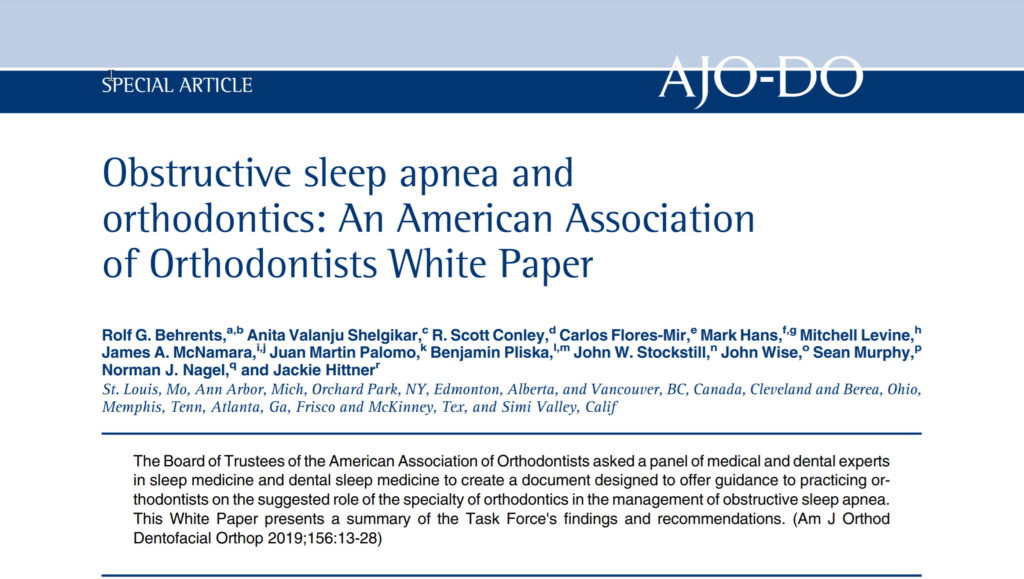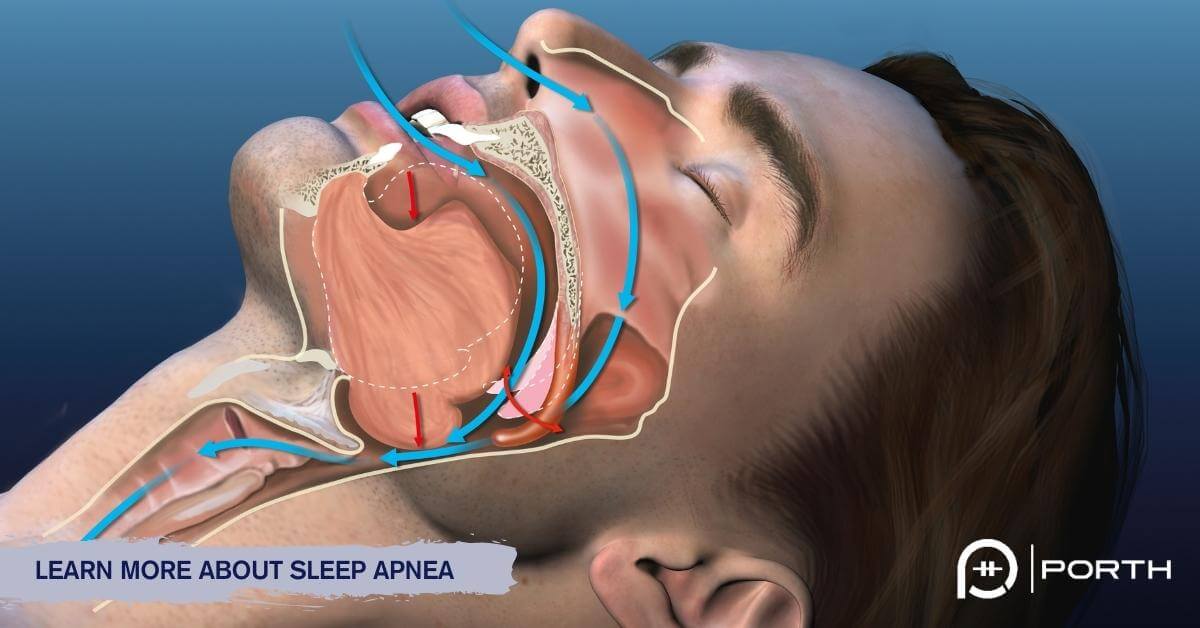Obstructive Sleep Apnea
Has anyone ever told you that you snore? Do you suffer from chronic fatigue despite getting a full night of sleep? Do you feel excessive daytime sleepiness?
You may be suffering from a sleep disorder called obstructive sleep apnea, and your orthodontist could play an important role in helping you address your condition.
Some people first learn about sleep breathing disorders when they see an orthodontist. Orthodontists and jaw surgeons often work closely with sleep doctors to run tests and diagnose sleep breathing disorders.
How can your orthodontist help you?
Let’s start by explaining the basics of obstructive sleep apnea.
What is obstructive sleep apnea?
Sleep apnea is a condition in which your breathing is interrupted while you are asleep.
There are two main kinds of sleep apnea: central sleep apnea and obstructive sleep apnea.
Central sleep apnea – when breathing is interrupted by a miscommunication between your brain and the muscles that control breathing.
Obstructive sleep apnea – when a physical obstruction temporarily blocks your airway while you sleep. The blockage happens when soft tissues in the throat collapse together. This could be blockage of the nasal airway or lower airway.
Both types of sleep apnea cut down on your body’s oxygen supply during sleep. Obstructive sleep apnea (often abbreviated OSA) is the most common type, however, and it’s the easier one to treat.
Quality of life is often impacted by OSA. Sleep apnea is a medical condition that can induce major health problems. Most patients are wearing CPAP or a variation of sleep devices that pushes their mandible forward. CPAP creates continuous positive airway pressure and prevent collapse of pharyngeal space.
The prevalence of OSA
Obstructive sleep apnea is common, but no one knows for sure just how prevalent it is because the condition often goes undiagnosed. OSA can only be diagnosed through a series of examinations by a sleep physician including a sleep study.
The airflow during your sleep will be analyzed during a sleep study along with your hearth and brain activities – polysomnography. The collected data summarized in an index called apnea-hypopnea index (AHI).
According to some global estimates provided by organizations like the American Academy of Sleep Medicine, around one billion adults between the ages of 30 and 70 have OSA. On a national level, 22 million Americans could have some form of sleep apnea.
The total number of people affected by OSA is small, but according to researchers, as many as 80% of cases of OSA are undiagnosed.
It’s important to recognize the signs of obstructive sleep apnea so you can take action by getting a definitive diagnosis from a sleep physician. Sleep apnea treatment is a treatment plan done by a team including an orthodontist.
The dangers of leaving OSA untreated
Snoring can be comedic, but OSA is no laughing matter with detrimental side effects.
What makes sleep apnea so serious?
The American Sleep Apnea Association states that OSA is connected with some life-threatening problems.
For example, fatigue caused by sleep apnea leads to an increased risk of car crashes and work-related accidents.
In the long term, OSA can lead to:
- High blood pressure (hypertension)
- Heart disease (cardiovascular diseases)
- Depression
- Type 2 diabetes
- Complications while having general anesthesia for surgery
It’s vital to recognize the signs of OSA and get treatment. Breathing easily at night is your key to enjoying a healthy lifestyle.
Signs you may have OSA
The most common signs of obstructive sleep apnea are:
- Snoring
- Gasping for breath at night
- Waking up with a headache or a dry mouth in the morning
- Drowsiness, fatigue, irritability, and difficulty concentrating during the day
Snoring is the most common and noticeable sign of OSA. But most people simply view snoring as something annoying, embarrassing, or funny and don’t know that it could be a sign of sleep apnea.
Snoring happens when someone has to force air past the relaxed tissues in their throat every time they breathe in. If you know that you regularly snore or if a sleeping partner has told you that you snore, then there’s a possibility that you have OSA.
Not everyone with OSA experiences snoring, however. Chronic fatigue could be another sign that you’re not getting enough oxygen when you sleep. Sleepiness and trouble concentrating or focusing on tasks during the day suggest that something is wrong with your breathing at night.
Signs of sleep-related breathing disorders in children
Even children can experience obstructive sleep apnea or sleep-disordered breathing.
Snoring is not a common in children with OSA, so if you’re worried about your child’s risk for sleep apnea, look out for common signs including:
- Mouth breathing
- Bed wetting
- Night sweats
- Night terrors or frequent nightmares
- Uneven breathing
- Coughing or choking noises
- Poor performance in school
- Tiredness during the day
- Inadequate weight gain
- Hyperactivity and difficulty concentrating during the day
Keep in mind, however, that sleep disorder in children is a very complex issue. Having one or even more of the symptoms listed above doesn’t guarantee that your child has a sleep breathing disorder.
OSA is just as dangerous for children as it is for adults. So if you’re worried that your child may have a sleep breathing disorder, ask your child’s pediatrician about the possibility.
Alternatively, you can also directly contact a sleep physician who specializes in treating kids.
Do you have the risk factors for OSA?
A sleep study conducted by a sleep physician is the only way to know for sure whether you have obstructive sleep apnea.
But there are certain conditions that may predispose you to developing obstructive sleep apnea. If you meet some of these criteria and you are showing signs of sleep apnea, then you could have an undiagnosed case of OSA.
Risk factors for OSA include the following.
Obesity – high BMI. Most OSA patients are overweight. Excess tissues around the neck can press on it and close off the throat while sleeping.
Male gender. Men are more likely to have OSA than women.
Neck circumference. If you have a wide neck, you are likely at risk for developing OSA.
Jaw size. A recessed or underdeveloped lower jaw can slide backwards when you sleep and close off your airway. Patients with certain craniofacial skeletal and dental patterns like class II malocclusion are more prone to develop OSA.
Tonsil size. Large areas of soft tissue in your throat including your adenoids, tonsils, soft palate, uvula, and tongue can obstruct your breathing at night.
Alcohol use. Alcohol relaxes your muscles, so indulging in alcohol before you sleep can make your head and body slump into odd positions that cause your throat tissues to collapse.
Allergies and sinus problems. If you suffer from chronic inflammation in your sinuses, then these can create airway obstruction and lead to OSA.
Children can also be predisposed to OSA due to similar factors. For example, children who have large tonsils or who are overweight may be at risk for OSA. Pediatric sleep apnea has also been noted in children with neuromuscular disorders and other underlying conditions.

Braces and OSA: how your orthodontist can help
Some orthodontists and dentists are trained to recognize the ways OSA can affect their patients. Although an orthodontist will not diagnose you with sleep apnea, they will examine your mouth and let you know if they notice any potential signs of OSA. Treatment of OSA is more than just getting braces or jaw surgery.
If necessary, an orthodontist will refer you to a sleep doctor who is qualified to give you a definitive diagnosis. This is usually done in a controlled sleep study setting measuring apneic events at a sleep center. Orthodontists, oral surgeons for surgical treatment, and sleep physicians often collaborate on sleep abnormalities. For example, surgical mandibular advancement, maxillary expansion or maxillomandibular advancement. Orthodontic treatment fix the occlusion after the surgery.
Even if an orthodontist does not diagnose OSA, what about orthodontic treatment? Can braces or clear aligners help if you have obstructive sleep apnea?
Patients on oral appliance therapy for OSA often experience changes in dental arches hence moving from medicine to dentistry side for potential dentofacial remedies. Treatment options to address dental changes formed as a function of oral appliances are diverse. Dental sleep medicine has been expanded in recent years.
Stay tuned because we’re going to clear up some myths and explain the latest research on orthodontic treatment and sleep apnea.
Our next article will highlight the most effective research-backed treatments for OSA.
